Wirral Tramway Company
History
The Wirral Tramway Company was formed in 1874 with the aim of building a 3-mile, standard-gauge horse tramway from Woodside in Birkenhead, southwards to New Ferry in Tranmere; the directors included William Busby of Liverpool, who along with his brother Daniel, was involved in the construction of several major horse tramways in the north of England. Powers to build and operate the tramway were obtained on the 7th August under the Wirral Tramways Order, which was authorised under the umbrella of the Tramways Orders Confirmation Act, 1874.
There now followed a hiatus, construction of the horse tramway only commencing on the 7th September 1876, and then slowly proceeding in a stop-start fashion. Horse-drawn services finally commenced on the 28th March 1877, though only over circa 2.5 miles of track, the northern 0.43 miles remaining for the time being uncompleted, due to railway tunnelling works under the route. The problems with the new tramway were, however, only just beginning, as the inspector was not satisfied with the laying of the setts around the track, and would only authorise the opening provisionally. The inspector subsequently returned on the 23rd May 1877 to open the completed northern section, but was far from impressed, and would not authorise its use until various improvements had been made. The company, rather unwisely, decided to open the new section anyway, with predictable consequences for their relationship with the Board of Trade, though matters were eventually resolved to the latter's satisfaction.
An extension into Woodside Ferry, built and owned by Birkenhead Improvement Commissioners (the local authority), was opened on the 19th January 1878, the WTCo paying to use it, as did the other two horse tramways which operated into the ferry (the Birkenhead Tramways Company, and the Hoylake and Birkenhead Rail and Tramway Company). This took the WTCo's standard-gauge horse tramway to its greatest extent of 2.99 miles. From a terminus in New Chester Road, New Ferry, just short of the latter's junction with New Ferry Road, the line ran northwards along New Chester Road, through Rock Ferry and Lower Tranmere, before curving northeastwards along Chester Street to the northern terminus at Woodside Ferry, Birkenhead. Additionally, there was a short line in Birkenhead, which looped off the main line in Chester Street, via Ivy Street and Church Street, before rejoining Chester Street.
The track in general — both the quality of its construction and the design selected — proved to be hugely problematic, and it soon deteriorated under the heavy loadings, the entire line being completely relaid in 1879 at considerable cost; fortunately, revenue was strong, so the company was able to stand a financial blow that may have sunk other concerns, given that it came a mere two years after opening. The original seven single-deck horsecars were also replaced at the same time, these, like the track, having been too lightly built.
Prosperity continued into the 1880s, but there was no escaping the impact of the opening of the Mersey Railway Company's tunnel under the river and its new station at Green Lane in Tranmere (1st February 1886), which though not initially affecting passenger numbers, certainly did when the railway was extended to Rock Ferry in 1891. With traffic falling away, and the company having borrowed money (in the form of debenture shares), it soon found itself unable to pay the loans back, even though it had taken the precaution of insuring itself, as the insurance company failed. In early 1894, the WTCo was forced to go cap in hand to Birkenhead Corporation, a move which resulted in the latter taking over the track in Birkenhead (it already owned all the track of the H&BR&TCo, as well as the Birkenhead United Tramway, Omnibus and Carriage Company, the successor to the BTCo). The corporation's common sense seems, however, to have deserted it, as not only was the WTCo track in appalling condition and in need of renewal, but they then compounded the error by granting the company a 21-year lease (from the 11th March 1895), which they would have to buy the company out of less than 5 years later.
The Birkenhead loop line via Church Street and Ivy Street was closed in the same year (1895), presumably as a cost-saving measure during the borough-funded reconstruction of the tramway.
By this time, the corporation was giving serious consideration to conversion of its horse lines to electric traction, and thereafter, operating the system as a municipal concern. Powers to operate the tramways, and to use mechanical traction, including electrical, were granted to the corporation on the 15th July 1897 under the Birkenhead Corporation Act (1897). The council formally decided to proceed with the creation of a municipally operated electric tramway system in May 1898.
The corporation now sought powers to buy the WTCo out of its lease (set for the 31st December 1899), and to build an additional nine miles of tramway; these were granted on the 20th June 1899 under the Birkenhead Corporation Act (1899). Although the WTCo was allowed to continue running horse-drawn services beyond the end of the lease, and until such time as the line (to New Ferry) was ready for reconstruction, agreement on the finer details of the operational arrangement could not be reached, the WTCo running its last horse tram service on the 8th May 1900. This was, however, just a short interregnum in the horse-tram service, as the corporation asked the BUTO&CCo to step in, which it did on the 16th May 1900, the final horse tram, still in WTCo livery, running some eight months later on the 22nd January 1901.
Uniforms
Photographs of the early days of the tramway company have not survived, or are at least yet to come to light, so it is currently impossible to say whether official uniforms were issued or not during these years. Fortunately, the last decade of operation, and particularly the last couple of years (the late 1890s) are reasonably well-represented photographically, so it is possible to state with some degree of confidence what was worn.
In common with the majority of horse tramways in the British Isles, drivers simply wore heavy-duty informal attire — trousers, jackets, and the normal headgear of the day, invariably the bowler hat. Conductors probably wore informal attire, i.e., robust jackets and trousers, along with a hat of some description, either a kepi or a close-fitting cloth cap. At some point, long overcoats were introduced, which were not dissimilar to those worn by the conductors of another local concern, the BUTO&CCo, suggesting that they came from the same supplier. Indeed, it is entirely possible that the company required its conductors to buy these garments, as well as the kepi-style caps — which were badgeless — a not-uncommon practice amongst horse-tram operators.
Further reading
For a history of the Wirral's tramways, see: 'The Tramways of Birkenhead and Wallasey' by T B Maund and M Jenkins; LRTA (1987).
Images
Horse tram drivers and conductors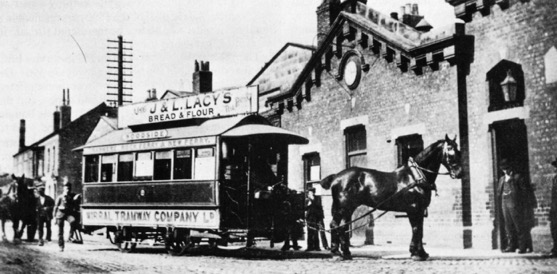
Wirral Tramway Company Horsecar No 9, pictured in front of the New Ferry depot — photo undated, but almost certainly taken in the last years of operation. Photo courtesy of the Tramways and Light Railway Society, with thanks to David Voice.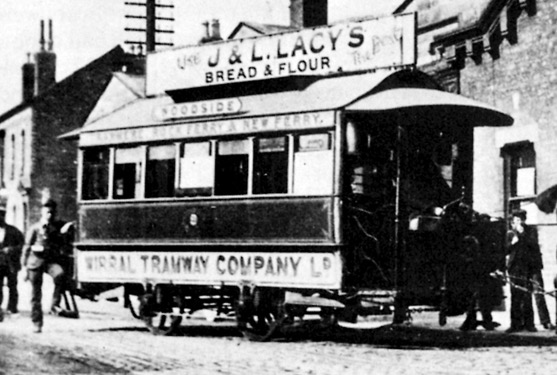
An enlargement of the above photograph showing the conductor, who is probably wearing a kepi-style cap.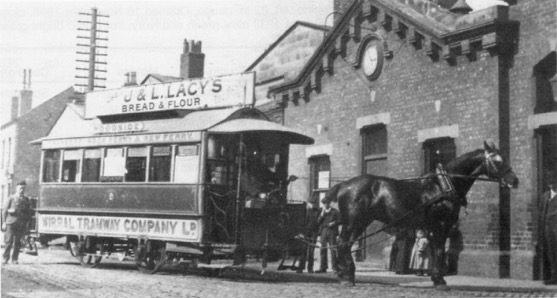
The same horsecar as above (No 9), on the same day, but taken just two minutes later than the previous photograph, at 5 minutes to 3 o'clock (see clock above the office door). Photo courtesy of the Tramways and Light Railway Society, with thanks to David Voice.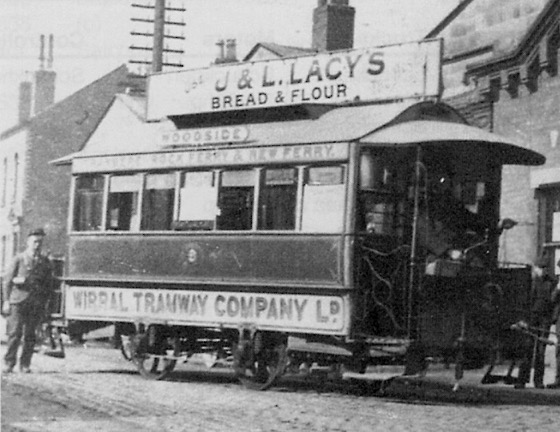
An enlargement of the above photograph showing the conductor, in a little better detail than the first image. Photo courtesy of the Tramways and Light Railway Society, with thanks to David Voice.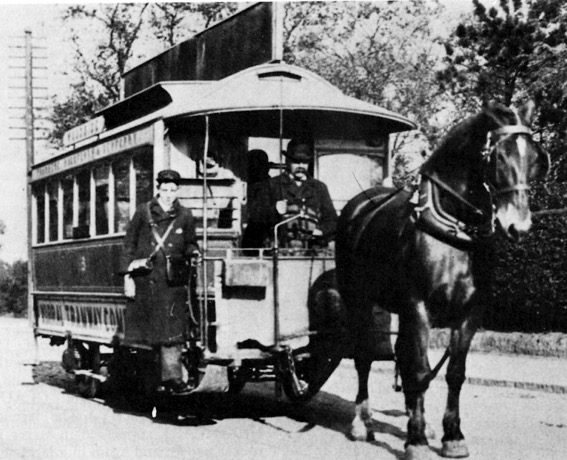
Wirral Tramway Company Horsecar No 8, pictured in New Chester Road — photo undated, though it may have been taken on the last day the company worked the service (8th May 1900). The driver is wearing fairly standard horse-tram attire, whilst the conductor sports a kepi-style cap and long overcoat. The cap would either have been issued by the company or would have been a requirement of employment, the wearer having to fund this himself; it does not appear to carry a badge of any kind. Photo courtesy of the Tramways and Light Railway Society, with thanks to David Voice.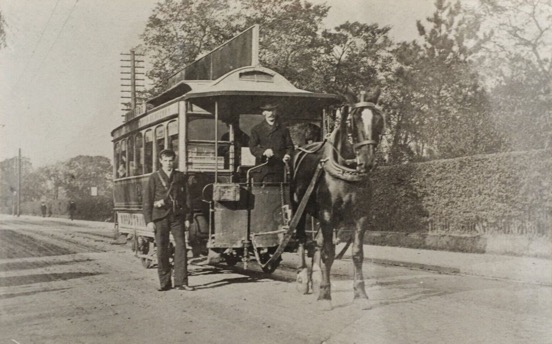
Horsecar No 4 of 1879, the second vehicle with that number, stands in what would appear to be New Chester Road with its crew. Although undated, the poor condition of the vehicle suggests that it was taken late on in the company's life, and there is even a possibility that it was taken after the demise of the WTCo, i.e., during the eight months that the Birkenhead United Tramway, Omnibus and Carriage Company operated the tramway (between 1900 and 1901).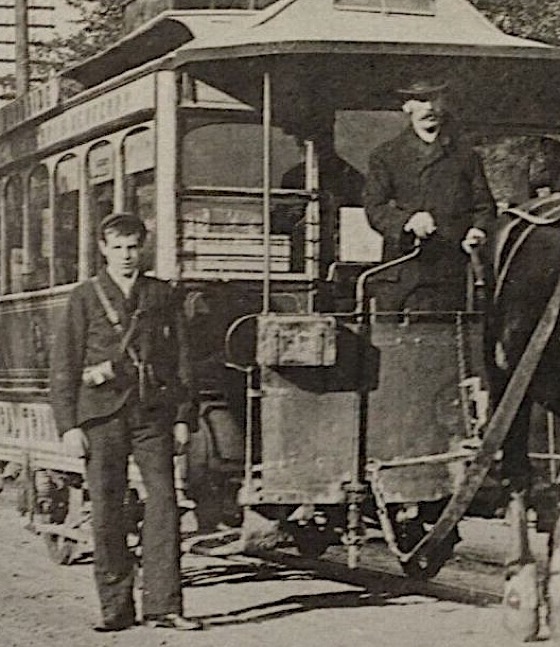
An enlargement of the above photograph showing the conductor and driver, both of whom are wearing informal attire, without badges of any kind.